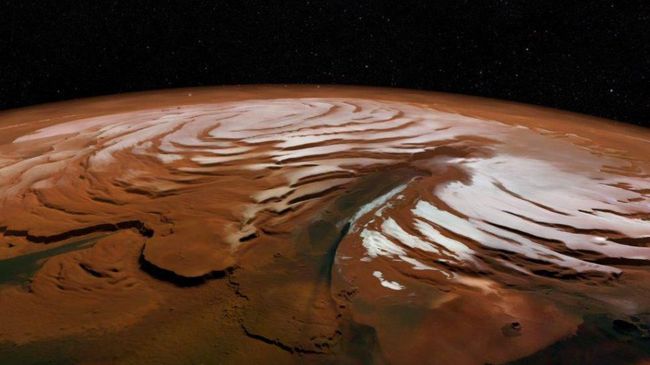The last telluric planet, the 4th of the solar system is Mars, nicknamed the Red Planet because of the color of its surface or the “god of war” of the time of the Romans because of its red-bloody appearance in the sky.
Mars has a diameter of 6787 km, which is half the Earth for a mass equivalent to only 10% of that of our planet.
Mars gravitates 228 million kilometers from the Sun and can approach up to 56 million kilometers from the Earth during perihelic oppositions that occur every 764 days and always between summer and autumn. It is at this time that it must be observed because its diameter reaches then 20 to 25 “(half of that of Jupiter) and it becomes almost as brilliant as Jupiter.
Mars is escorted by two small satellites, Phobos (14 km) and Deimos (22 km), which are ancient asteroids that were captured 3 or 4 billion years ago.
On March, the duration of the day is 24h 37m 23s and the year lasts 687 days. Practically like the Earth, Mars is inclined 25 ° 19 ‘in its orbit. So it knows seasons similar to those we know, but twice as long.
Due to the eccentric shape of its orbit (elliptical and off-center), during Mars summers, Mars approaches about 20% of the Sun and its ground temperature can reach 35 ° C in the shade according to the measurements made by the rover Spirit in 2007. But on average, its temperature is close to -63 ° C. Mars is an icy planet.
Between 1964 and 2015, we sent 43 space probes to Mars, only half of which were successful, the others having either been lost en route or failed as soon as they arrived.
Thanks to the Mariner, Viking, Sojourner, Spirit, Opportunity, Curiosity, Phoenix and other MRO orbiter space probes, some of which still work, scientists have discovered the true face of Mars, far removed from science-fiction novels and “little green men”. “. No, there are no aliens on Mars but only a few robots sent by the Terrans!
Thanks to the data collected by all these space probes, we now know that Mars has a weak atmosphere but that does not allow us to breathe (pressure of 6 millibars against 1013 millibars on Earth at sea level).
From a meteorological point of view, there are light clouds of altitude, mists, depressions, strong sandstorms and whirlwinds, in short, structures found on Earth in the deserts.
Like Earth, Mars also has two polar ice caps. That of the North Pole contains water ice (the same as that found on Earth) while that of the South Pole contains mainly dry ice (85%) mixed with ice water. These polar ice caps have a thickness of up to 3 km forming a terraced spiral structure.
As the photographs show, the surface of Mars also includes countless craters, large canyons several hundred kilometers long (Valles Marineris), extinct volcanoes including Olympus Mons reaching 26 km altitude or 3 higher than Everest as well as hills and mountains, huge fields of dunes or stones.
More interestingly, frost deposits and small streams of salt water (up to 5 m wide and 100 m long) appear in the early morning on the slopes of craters or dunes.
Despite the numerous holes drilled by the exploration robots in the soil of Mars and the analysis of hundreds of samples, no form of life, trace of their activity or even a fossil has been discovered to date on the planet. Red. For now, Mars is a barren planet and a frozen desert.


ok
Woow
Very interesting
zzz
addadaa
tnx
trhu
grdgrd
bdsaudegdjids dsahdsaiwdh
zzz hhh